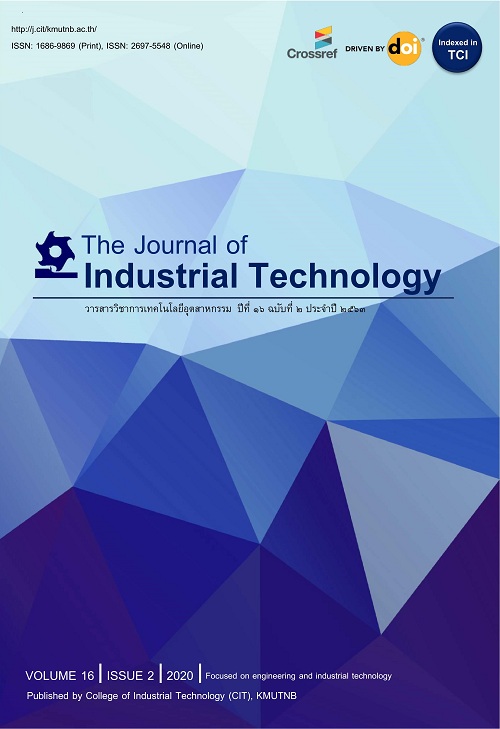Development of Infectious Waste Prototype Bin for Public Toilets in Commercial Buildings
การพัฒนาต้นแบบถังขยะมูลฝอยติดเชื้อในห้องน้ำอาคารสาธารณะ
Abstract
งานวิจัยนี้มีวัตถุประสงค์เพื่อสร้างต้นแบบถังขยะมูลฝอยติดเชื้อในพื้นที่ห้องน้ำอาคารสาธารณะให้สามารถทำลายเชื้อที่ปนเปื้อนมากับขยะเพื่อลดความเสี่ยงของการแพร่ระบาดโรคติดต่อ โดยทำการสำรวจถังขยะในห้องน้ำของห้างสรรพสินค้าและออกแบบต้นแบบถังขยะโดยบูรณาการความรู้ด้านการออกแบบกับหลักการทำลายเชื้อขยะที่ปนเปื้อนสารคัดหลั่ง ซึ่งถังขยะแบ่งออกเป็น 3 ส่วน คือ (1) ถังชั้นบนสุดสำหรับทิ้งขยะกระดาษชำระ ฝาถังเปิดปิดอัตโนมัติเพื่อลดการสัมผัส (2) ถังชั้นกลางเป็นชั้นที่รวบรวมขยะและทำลายเชื้อ โดยการพ่นน้ำยาทำลายเชื้อให้ทั่วถึงพื้นที่ผิวขยะทั้งหมด ด้วยสารประกอบโซเดียมไฮโปคลอไรท์ 0.1% ผ่านหัวพ่นหมอก 2 ตำแหน่ง ซึ่งวัสดุเป็นทองเหลืองมีอัตราการไหล 7 ลิตรต่อชั่วโมง สามารถพ่นกระจายน้ำยาได้ทั่วถึงภายในระยะเวลา 45 วินาที แล้วกักขยะส่วนนี้ไว้อีก 15 นาที เพื่อประสิทธิภาพในการทำลายเชื้อแล้วจึงนำส่งขยะไปยังถังชั้นล่าง (3) ถังชั้นล่างซึ่งออกแบบเป็นลักษณะลิ้นชักสำหรับเปิดจัดเก็บขยะที่ผ่านการทำลายเชื้อแล้วเพื่อนำไปกำจัดเหมือนขยะทั่วไป และผลิตต้นแบบเพื่อประเมินผลการใช้งานจากเจ้าหน้าที่บริหารจัดการอาคารและบุคคลทั่วไป ผลการประเมินพบว่า (1) ถังขยะมูลฝอยติดเชื้อในห้องน้ำสาธารณะต้องสามารถวัดผลด้านการทำลายเชื้อได้จริง (2) บุคคลทั่วไปมีความพึงพอใจในด้านการใช้งาน ความสวยงาม การรับรู้ถึงประโยชน์ของการใช้งาน และการตัดสินใจซื้ออยู่ในระดับ
The research aims to create a prototype infectious waste bin for public toilets in commercial buildings to automatically disinfect contaminated toilet paper to prevent the spread of diseases. This study explores commercial buildings to analyze toilet waste management and to design a bin prototype with 3 sections. (1) The first level is a touchless lid for receiving toilet paper waste. (2) The second level is to be sprayed thoroughly over its entire surface with disinfectant (0.1% or 1000 ppm sodium hypochlorite) via 2 positions of fog nozzles made of brass with a flow rate of 7 liters per hour spread disinfectant evenly cover all of the waste within 45 seconds and retrained for 15 minutes to eliminate germs. (3) The waste then passes to the third or bottom level, which operates as a drawer that staff opens to retrieve the waste. The study gathers feedback from facility managers to evaluate the innovative product and establish its credibility. The first factor to be considered is its effectiveness in disinfection. User feedback on functionality, aesthetics, usefulness, and purchase decision is positive. The results of the prototype bin disinfection test showed that it could completely eliminate E. coli. and 99.995% to eliminate B. subtilis.
Keywords
[1] https://ddc.moph.go.th/viralpneumonia/faq_more.php. (Accessed on 25 May 2022)
[2] https://www.anamai.moph.go.th/ewt_dl_link.php?nid=16722. (Accessed on 7 July 2020)
[3] P. Akkajit, Infectious waste and infectious waste management in hospitals. Environmental Journal, 2019, 21(1), 31-39. (in Thai)
[4] R. Takoporn, Infectious waste management behaviors within household: a case study of Chombueng, Ratchaburi province, Thesis, Silpakorn University, Thailand, 2015.
[5] W. Khawboonchu, The factors that have an effect on infectious waste management by public health personnel in Kanchanaburi, Thesis, National Institute of Development Administration, Thailand, 2009.
[6] S. Chandanachulaka, S. Tookaew, P. Krabkran, T. Hirunrueng, P. Sridaromont, Study for improving infectious waste management efficiency in Thailand, Thailand Journay of Health Promotion and Environmental Health, 2021, 44(3), 115-128. (in Thai)
[7] N. Indrawattana, M. Vanaporn, Nosocomial infection, Journal of Medicine and Health Sciences, 2015, 22(1), 81-92.
[8] https://hpc2service.anamai.moph.go.th/envdata/files/8.pdf (Accessed on 7 June 2023)
[9] https://web.tcdc.or.th/th/Articles/Detail/Covid-UV-C (Accessed on 9 July 2020)
[10] https://siamrath.co.th/n/149956 (Accessed on 9 July 2020)
[11] H. Jatana, M. Jongsuphanphong, T. Pankrib, P. Chantawon, Design and development of disinfected bin using ozonization with high pressure plasma system, The Journal of Applied Science, 2016, 15(2), 1-11.
[12] https://covid19.anamai.moph.go.th/web-upload/2xdccaaf3d7f6ae30ba6ae1459eaf3dd66/m_document/6736/34126/file_download/49d59084c556cf0dea1d97c97d4cb0e0.pdf (Accessed on 7 July 2020)
[13] C. Polpong, C. Ngamsang, W. Polpong, K. Buapha, Automatic sterilization arched entrance, Industrial Technology Journal Surindra Rajabhat University, 2022, 7(1), 58-65.
DOI: 10.14416/j.ind.tech.2024.08.006
Refbacks
- There are currently no refbacks.






